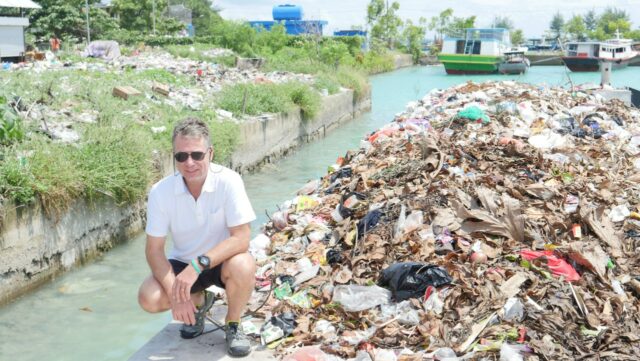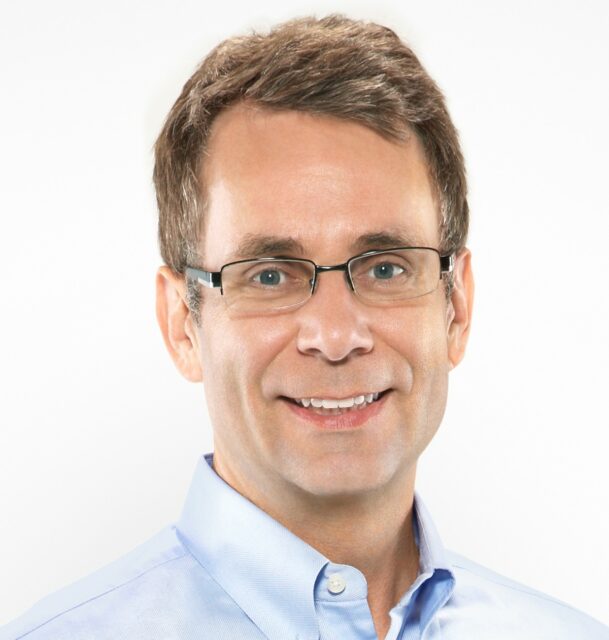By Stephanie Walden, contributor, and Sara Alvarez Kleinsmith, thought leadership, Dell Technologies
The package is finally at your front door—it’s the new laptop you’ve eagerly anticipated for weeks. But your enthusiasm wanes as you begin the unboxing process. You peel off the Styrofoam, bubble wrap and yet another layer of plastic film. Is all this really necessary?
In Oliver Campbell‘s professional opinion, the answer is simple: No, it’s not. Campbell, the director of packaging engineering and a distinguished engineer at Dell Technologies, has helped the company adopt materials with a lower environmental impact. Over the past decade, Campbell has introduced renewable and recycled materials—such as protective natural fiber cushions—and these revolutionary materials have become an industry standard. His team’s efforts also extend to ocean health, with 227,000 pounds of ocean-bound plastics diverted from entering the ocean in 2021.
Without the innovative and creative vision of leaders like Campbell, such revolutionary industrial progress wouldn’t be possible. According to Dell’s Breakthrough study, 53% of global workers worry their business will be shutout due to a lack of people with the right authority/vision. But Campbell’s leadership hasn’t just been good for business; it’s good for the planet. And he is proud of the global ripple effect his efforts have had. “There are seven and a half billion people on this planet, most of whom touch packaging multiple times a day,” he says. “This work can have a lot of horizontal impact—it can be quite powerful.”
Below, Campbell shares insights about his role at Dell and the future of sustainable materials.
Can you give a brief overview of your career path at Dell? How did you get into sustainable materials?

People refer to me as “the packaging guy.” I think that’s my unofficial title. I’ve been at Dell for nearly 24 years, and I’ve worked in a variety of roles. When I first started, I worked in manufacturing engineering. From there, I branched out into operational strategy and then logistics.
When a Dell executive approached me about the packaging role in 2008, sustainability was starting to gain ground. I had a personal interest in the topic, having grown up in a rural environment working on a farm. Nature and supply chain strategy has always resonated with me.
Though I came into the job with very little experience in packaging, I had a solid engineering background. I think having that engineering mindset was a tremendous advantage. It allowed me to ask questions and challenge the status quo. Why do we do things this way? Why do we make packaging from trees?
These questions were the start of a journey to establish a dedicated team that could come up with inventive solutions. Today, we have a global team of 20 people, and we’ve accomplished a lot. It’s been a phenomenal ride.
Can you elaborate on some of those accomplishments?
I would say that, in terms of our “greatest hits,” it all started with bamboo. That was the key that unlocked the move away from plastic packaging. Bamboo is the world’s fastest-growing plant. It also has some great mechanical characteristics in terms of tensile strength and fiber length. We started to make protective cushioning out of bamboo fibers. It took us about a year to develop a working prototype—it was very experimental. But we got it to work.
This discovery about bamboo showed that fibers could play a role in protective packaging, and it paved the way for the widespread use of lower-cost, molded paper pulp, which is made from recycled corrugate and newspaper.
Later, we started blending bamboo with waste materials like sugar cane pulp—you have this biomass as a waste product, and we started taking out fiber to blend it, and the combination of fiber properties created unique characteristics. In this case, it gives the material a very smooth feel. To the naked eye, it can be almost indistinguishable from polystyrene or plastic.
A lot of the sustainability innovations we’ve developed here at Dell have had benefits not only for the company and our customers but for the whole tech industry—and even other industries. We’ve seen these materials used in shipping everything from candles to food to wine bottles. It has really had a transformative effect, and it started here.
Sustainability is an aspect of every job these days. Whether you’re an engineer, a designer, or work in supply chain management or sales, there are always opportunities to think about sustainability and how you can do things more efficiently.
—Oliver Campbell, director of packaging engineering, Dell Technologies
Can you elaborate on the role that partnership and collaboration have played in this journey?

I’m particularly proud of the partnerships we’ve formed to reduce ocean plastic. We started in 2015 with Adrian Grenier, who was our Social Good Advocate at the time. He was very interested in ocean conservation, and we had a long meeting to discuss his vision and how Dell supply chain and our technology DNA could be part of a solution.
We reached out to Dr. Jenna Jambeck at the University of Georgia, who is famous for research that highlighted if we don’t change our ways by 2050, there will be more plastic than fish in the ocean. Her good advice to us was to focus on prevention rather than remediation. Her analogy was that if your bathtub is overflowing, it’s best to turn off the faucet before starting to bail water. This direction became the premise for our strategy of intercepting ocean-bound plastic before it does harm.
We quickly realized that although Dell is big, we are literally a drop in the ocean compared to the size of the problem. So, we teamed up with other like-minded organizations, one of which was the Lonely Whale Foundation, Grenier’s initiative. Together we formed NextWave Plastics, which is now a consortium of about 14 companies operating in nearly 20 countries. We’re working to build a commercially viable and scalable supply chain to intercept ocean-bound plastic.
That is really one of our greatest successes. NextWave showcases how an effective industry consortium can work to solve some really, really big sustainability problems.
What are some other in-the-works projects or initiatives you’re excited about? And what excites you about the future of the industry in general?
We’re 90% of the way toward our 2030 moonshot goal for all our packaging to be made from renewable or recyclable materials. We also met our United Nations Sustainable Development Goal—to prevent 160,000 pounds a year from entering the ocean—four years early.
In terms of our remaining 2030 moonshot goals, a key pillar is to complete the sustainable forest certifications for applications that use virgin fiber. We want to ensure the virgin-fiber component of our papers comes from sustainably managed forests. We’re finishing that up over the next year.
Plastic bag reduction is in our sights, too. Global estimates are that the world produces two to five trillion plastic bags a year. Nobody knows with certainty the exact number, but we do know they have a devastating impact on our oceans and land-based habitats. We believe that we can use our tech innovation DNA and supply chain chops to be a catalyst for change. Our teams are working hard across all functions—engineering, design, production, procurement, etc.—on how to eliminate the plastic bag, or if complete elimination isn’t possible, how to introduce a more sustainable alternative.
In terms of the future of the industry, we’re entering an era I call “packaging engineering 2.0.” The rise of digital information and the ability to simulate the performance of our packaging materials allows us to speed up our cycle times. It lets us advance designs in ways we couldn’t have before.
What would be your top piece of advice for other engineers or professionals looking to break into this line of work?
Sustainability is an aspect of every job these days. Whether you’re an engineer, a designer, or work in supply chain management or sales, there are always opportunities to think about sustainability and how you can do things more efficiently.
I do think it helps to have some subject matter expertise in at least one area, whether that’s tech, business, etc. I think it’s critical to have something you understand really well versus being a broad generalist—and then you can borrow ideas from that area and apply them to another.
The other thing is just to think big. Our goal from the very beginning was to be the best packaging engineering team on the planet. That’s obviously aspirational, but that type of thinking is important because it empowers us to be change agents and leaders and to take smart risks. Ultimately, I think sustainability is going to be with us for a long time. And it’s a great place to be.
Breakthrough Champions is a series on Perspectives profiling ordinary Dell employees doing amazing things to advance digital transformation. The series is inspired by Dell’s “Breakthrough” platform and the belief that progress happens at the intersection of people and technology.

